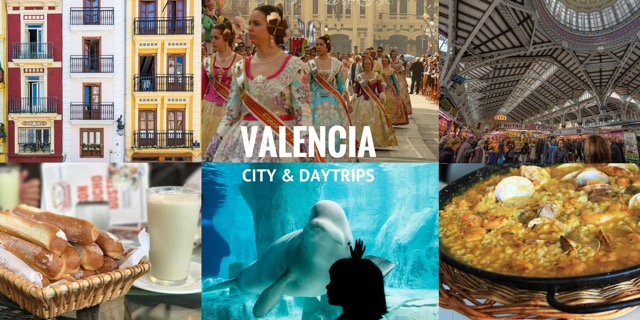Barcelona isn’t the only cool Spanish city on the Mediterranean. A little further down the coast, Valencia offers lots of style and charm as well as exceptional good value. Here at Totally Spain, we’ve been designing itineraries for the past 18 years and think Spain’s third city is a real must-see for the senses.
About Valencia City
The city centre is a wonderful combination of Gothic, Romanesque and Renaissance influences and nowhere is that more evident than at the city’s cathedral. The staggeringly beautiful 15th century Gothic Silk Exchange which is still used for trading today is another must-see. But what else draws us back to Valencia?
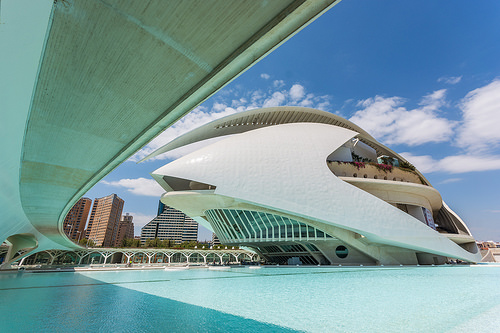
Valencia’s trademark blue skies with the stylish Calatrava lines of the City of Arts and Sciences (CAC in Valencian) begging to be photographed! photo credit: valencia (13) via photopin (license)
1 The Museums
Valencia city is best known for its wild and wonderful City of Arts and Sciences. Designed by home-grown ‘starchitect’ Santiago Calatrava, it is every photographer’s and sci-fi fans dream. Who knows what Santiago Calatrava was thinking of when he dreamed up this futuristic complex that contrasts so beautifully with the historic old city centre. Completed in 2005, it is fawned over by film crews for its sleek and stylish looks. For example, George Clooney (who filmed Tomorrowland there) described it as amazing and insane!
Built on the dried up river bed of the Turia, the City of Arts and Sciences is comprised of a science museum (El Museu de les Ciències Príncipe Felipe), a planetarium (L’Hemisfèric), an opera house (El Palau de les Arts Reina Sofía), an IMAX cinema and a promenade (L’Umbracle). You can read a detailed overview of the space here by the Wall Street International Magazine. Insider Tip: Make sure to set aside at least 2 hours to explore this space.
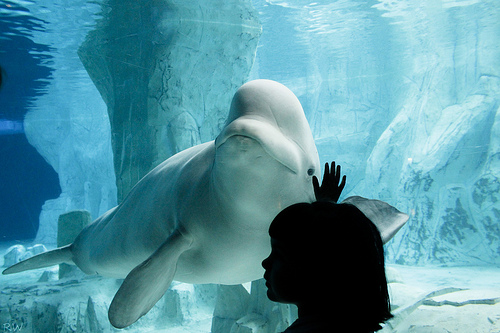
One of the many enchanting experiences of the Oceanografic in Valencia. photo credit: RaqueLobo Beluga junto a una niña via photopin (license)
We also recommend visiting The Oceanografic which takes a minimum of two hours to get around. This is Europe’s largest aquarium and it has all you expect which is 45,000 examples of 500 species located across the 8 different climates. Check out the dolphins, crocodiles, jellyfish, penguins, butterflies, cormorants, turtles, clownfish, sharks, starfish, flamingos, walrus’ and learn about the programmes run here to nurture and protect the animals. We suggest you start out your day when the space opens at 10am as it gets busy quickly. The only exception would be if you wish to spend the night here (yes , you can!). Another cool activity is to become a ‘dolphin, seal and walrus trainer’ for a day. Just two people can sign up per day and they must be aged 13 or older. NB This activity must be booked at least one week in advance of your visit.
Want to see a smaller museum to complement the scale of the City of Arts and Science? We like the views of the medieval city walls which are an added extra when visiting the IVAM. This museum takes a look at the 20th century art movements and features a large collection by the Barcelona-born sculptor Julio Gonzalez. You might need to ask directions for the underground room, which was discovered during the building works for the museum. Want to see a really niche museum? Check out the Rice Museum where you’ll see a restored rice mill.
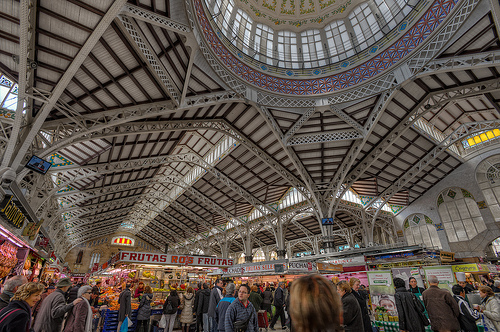
Shopping for food at the Central Market in downtown Valencia built in 1914. photo credit: marcp_dmoz Central Market – Mercado Central, Valencia (Spain), HDR via photopin (license)
2 The Food Markets
You have not one but two major treats in store in Valencia city when it comes to old food markets. First stop has to be the extravagant Art Nouveau building that is the Central Market. The Telegraph suggests we “gaze up at the tiled dome, adorned with painted oranges, then look down at the pyramids of the real thing at ground level and have a freshly squeezed juice at the bar outside the market. Full of flavour and zing, it’s like Valencia in a glass.” This market houses hundreds of food traders who get to marvel at the iron, glass and ceramic domes every day. Built in 1914, it was inaugurated by King Alfonso XIII back in 1928. It opens from 7am to 3pm Monday to Saturday. NB The market runs a home delivery service and its chilled lockers stay open until 9pm so if you purchase something and don’t want to carry it round for the day, you know what to do…
We also like Colon Market – a stunning modernist building from 1916 where you’ll find music recitals and lots of other cultural events amidst the shops, cafes and restaurants. It was once a fresh food market but it now more like a mall and is a very pleasant place to stop and have a drink. Opening times of the shops vary. The building itself is open from 7.30am until 1am every day.
Want to see another market? Check out Ruzafa Market built in 1957. It’s a completely different look and feel here to the other two – and you’ll find lots to look at, photograph and buy from the 160 food stalls serving this funky neighbourhood.
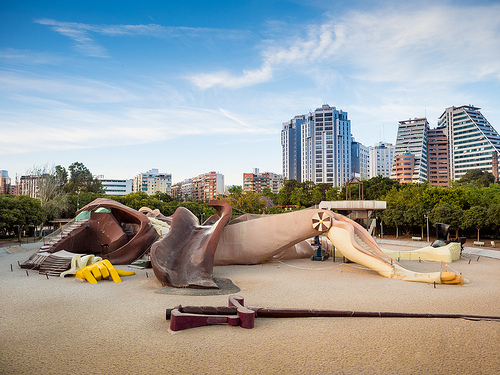
One of the great amenities in the city’s Turia Gardens is Gulliver Park! photo credit: wwarby Gulliver Park via photopin (license)
3 Valencia’s Parks
After all those museums and markets, you might need some of the great outdoors? We are huge fans of Turia Gardens. The space was created when the river was diverted away from the city centre following the catastrophic flooding in 1957. It’s nine kilometres long so you might want to hire a bike or a family-friendly 4 or 6- seater-bike to get around this elongated park which is one of the largest urban green spaces in Spain.
Want a suggested cycle route? Bike your way to the North of the Gardens, where you’ll find the Bioparc which is a savannah-like reserve featuring lions, giraffes, gorillas and elephants. In the middle of Turia Gardens, you’ll find the Botanic Gardens. Carry on and you’ll come to the House Museum of local painter José Benlliure. Continue on southwards to get to one of our favourite sections – Gulliver Park – an excellent free attraction and great place to see Valencian families at play. Here you’ll find an enormous model of the giant Gulliver – that can be climbed and explored – with some help from hidden steps, ropes and ladders. (NB You might want to wear rough clothes and old shoes as the giant is surrounded by dusty grit.) When you are done here, carry on cycling till you get to the Palau de la Musica (park up your bike and have a coffee or juice at the wonderful café here) before heading on to the lower section of Turia Gardens, where you reach the City of Arts and Sciences complex including the Oceanografic with its penguins, flamingos and dolphins.
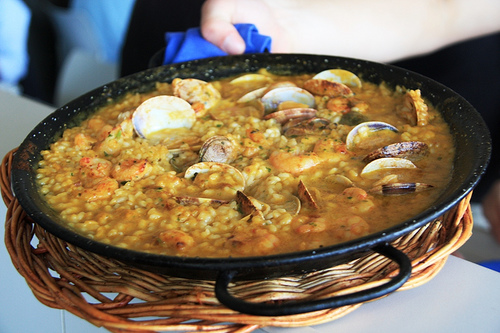
Spain’s most famous dish – paella – comes from Valencia! photo credit: jlastras Paella de Almejas y Gambas via photopin (license)
4 Paella & Beyond – What to Eat & Drink in Valencia
It seems a bit obvious but we have to recommend a glass of freshly squeezed orange juice every morning, don’t we? If you see ‘coca de llanda’ on offer at the same time – go for it! It’s a local sponge-like tray-bake cake. When it’s time for lunch, start off with ‘esgarraet’ which is a tasty appetiser consisting of salt cod, roasted sweet red peppers, garlic, and olive oil. And the main course? It has to be paella – at least one day. The name ‘paella’ actually refers to the flat frying pan used to prepare the dish. Today it’s often prepared with seafood but it started out as a very humble affair when it was first prepared in Valencia, the major rice-growing area in Spain, as a cheap and convenient meal for the workers in the rice fields.
The region of Valencia is still a major producer of rice. If you fancy a drive, you should visit the Albufera National Parkland (45 min drive from Valencia city) which is one of the largest freshwater parks in Spain – to learn about the ancient cultivation traditions still in use such as the flooding of the fields. When you’re there you can hire a boat. And you’ll get to choose one of the 20 or so restaurants preparing paella and other rice-dishes using local ingredients.
Wherever you taste your first Valencian paella, make sure to only order paella where it is freshly prepared. It should take 30 mins for the dish to be served and should require a min. of two people dining. After you have enjoyed a decent paella, you might want to try other dishes including ‘arroz a banda’ (a simpler paella-like dish), ‘arroz negro’ (with squid ink) and ‘arroz al horno’ (literally baked rice). To learn more about paella, read our detailed post here. Too much talk of rice? Try the fideua (a noodle-based paella served with wonderful ali-oli)
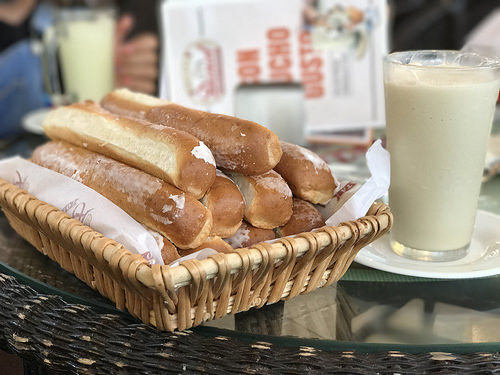
Move over churros! In sunny Valencia, you’ve got to try horchata and fartons! photo credit: felixmetalsucko Horchata y fartons via photopin (license)
If you are wondering what local snacks are on offer, we recommend ordering horchata – a refreshing almond-like drink made from a root called the tiger nut. Horchata is often served with ‘fartons’ which are a long strip of pastry to be dunked into horchata rather like you dunk churros into hot chocolate. In the mood for something more sophisticated with fizz? Order an ‘agua de Valencia’ which is cava with orange-juice.
Looking for a Michelin-style meal in Valencia city ? Quique Dacosta is the big name in this part of the world. He started out in neighbouring Alicante and now has three eateries in downtown Valencia: El Poblet, Mercatbar & Vuelve Carolina. If you like those spaces, you can drive the 1hr 15 mins to dine at the main three Michelin-starred Quique Dacosta restaurant which is actually quite a small venue on the beachfront at Les Marines in Denia (Alicante). The two tasting menus are priced at 210 EUR per person for 2018 with an optional wine pairing of 99 EUR (you can also order wines a la carte). We can arrange for a private driver to collect you from your hotel and drop you back again- to enable you to relax and enjoy the meal and its wine pairing to its fullest!
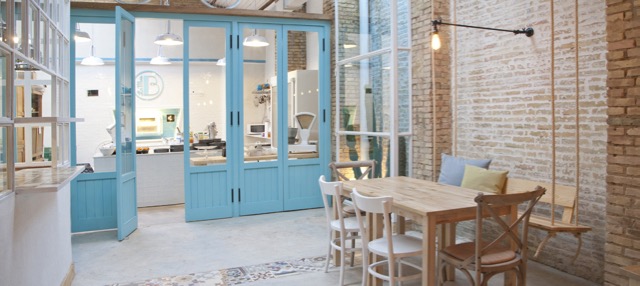
La Mas Bonita cafe and bakery in Ruzafa – the hippest barrio in Valencia. photo credit: La Mas Bonita
5 The Barrios, The Bridges & Beaches
After seeing the cathedral, the Central Market, the Silk Exchange, and the CAC, you’re probably ready for a few different barrios or neighbourhoods, right? We love El Carmen (north of the old quarter) which is great for traditional tapas and lots of niche museums. We are also very keen on Ruzafa (south of the old quarter) for more contemporary eateries and hip bars. We were regulars in La Mas Bonita café and bakery in Ruzafa (which also has a branch in La Patacona neighbourhood near the beach.) If you’d like to get to know Valencia’s barrios, we’d be very happy to prepare a guided walking tour or gastronomy tour for you.
You can’t ignore the port and coastline either. We like the harbour area by Veles e Vents. And the wonderful Playa del Cabanyal and Playa de la Malvarrosa. If you like fine-art, you are probably familiar with Joaquin Sorolla’s famous works depicting Malvarrosa beach. Sorolla was from Valencia and captured the light and landscape perfectly. Valencia is very proud of him and named the train station in his honour. We’d love to put together a Sorolla-inspired tour of the city if you are as enchanted by his work as we are!
After the barrios and the beaches, the other features that are unique to Valencia are the dozens of water-less bridges over the old River Turia. Our favourite is the Puente de las Flores (Flower Bridge) but there’s something for every style and taste. Again, we can put together a walking or cycling tour of the bridges for you.
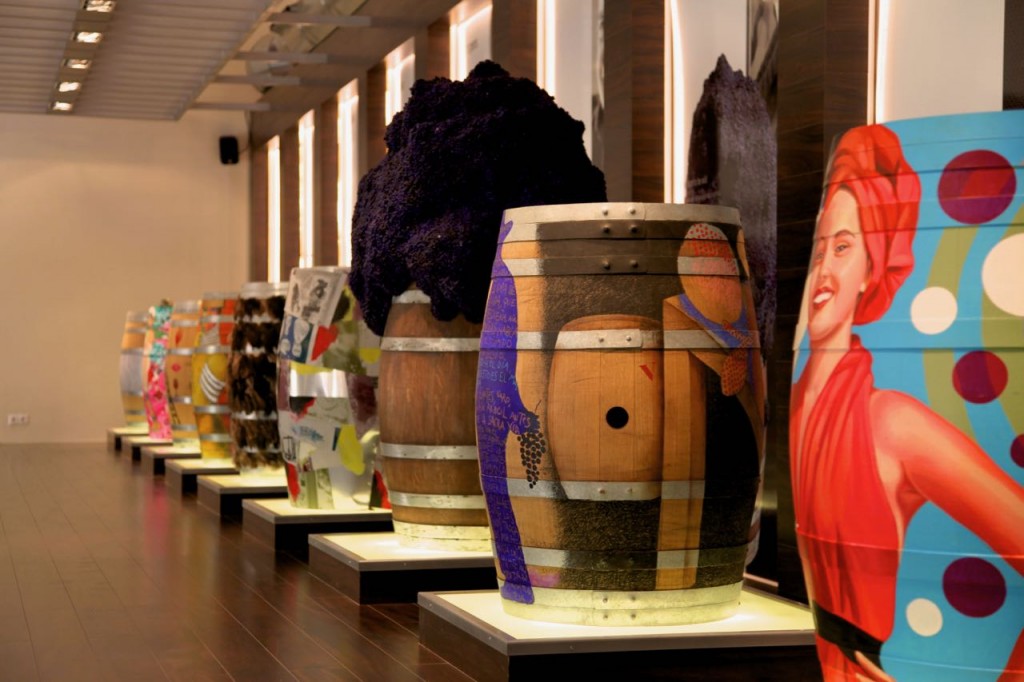
The elaborate wine barrels painted by artists such as Mariscal at Finca Hoya de Cadenas. photo credit: Vicente Gandia
6 Daytrips from Valencia
The Wine & Winery Daytrip
Just one-hour from Valencia city, you’ll find the vineyards in Utiel-Requena that produce the Bobal grape. Requena is well-known for its Cuevas de la Villa (an underground cave). Closer to Utiel you’ll find one of the largest wineries in the region – Hoya de Cadenas – which was founded in 1885 and is managed by the fourth generation of the Gandia family. We featured this winery in our winery with art post because its Museum of Barrel Art contains wonderful wine barrels decorated by famous Spanish artists such as Javier Mariscal, Miquel Navarro, Carmen Calvo, Uiso Alemany and José Sanleón. The wine bottle labels are inspired by the artists’ designs which make for wonderful gifts. We can program your itinerary and provide a driver to take you around this Utiel-Requena DO.
Peñíscola as seen in Game of Thrones
When the locations manager for Game of Thrones chooses your city, you know you’ve got style and substance and Peñíscola has all this and more. It’s only a 1hr 45 min drive from Valencia city along Spain’s Orange Blossom Coast and you’ll be spellbound by this charming walled city and its impressive 14th century castle-fortress overlooking the coast. An important cog in the Mediterranean’s Middle Ages, you’ll find popes and the Knights Templar have made their presence felt here. Today it’s a very welcoming destination with its sandy beaches and port, castle, lighthouse, artillery park and hop-on-hop-off ‘train’ which is handy for groups with reduced mobility and young families. We also featured Peñíscola in our guide to short roads trips in Spain.
Shoe Shopping
Love shoes? Did you know that Spain is a major shoe manufacturer and this region is home to some of the biggest and best brands in the country? 48 percent of all the shoes exported from Spain are made in the Valencia area. We can put together the perfect shopping session for you – in Valencia – or even better – arrange for a driver to collect you and drive you to the Pura Lopez, Rebeca Sanver and Panama Jack stores and outlets in Elche and Elda (about 1hr 45 from Valencia city). And if you’d like a bottle of bubbly to celebrate the purchases on your way back to the city, we can arrange that also! To learn more about the shoe industry in Spain, read our post here.
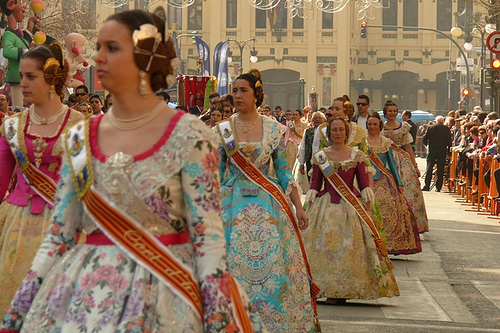
In between the gunpowder demos and flaming sculptures, the falleros and falleras! photo credit: calafellvalo Fallas Valencia 2010 (112) via photopin (license)
7 Festivals in and around Valencia
Valencia city’s best-known festival is Las Fallas where giant figures called ‘ninots’, made from paper, wax, wood and Styrofoam, are displayed before being burned ceremoniously. Yes – you read that correctly – an entire year’s worth of labour goes up in smoke annually on 19 March. Events begin on the first of March with the Mascleta which is a display of gunpowder explosions that continues daily until 19 March. The giant figures are exhibited on the 16 March and prizes are awarded on the 17 March. Fireworks take place nightly from 15-19 March. There are parades on the 17 & 18 March and the burning of the figures – known as La Crema – takes place on the 19 March. If you visit Valencia outside of these dates, go along to the Fallas Museum to see the ‘ninots’ that have been spared burning. You can also visit the Fallero Guild Museum.
If you’re travelling with university students in late August, they’ll may want to get involved in La Tomatina in Buñol (35 min drive from Valencia) where party-goers fling ripened tomatoes around the town for 60 minutes of madness to celebrate the harvest. This takes place on the last Wednesday of August.
The FIB Benicassim Music Festival (one hour drive from Valencia) is also a huge annual event in mid-July.
If you enjoy the theatre, head for Sagunto (30 mins from Valencia city) especially during the Theatre Festival in July and August. Many events take place at the Roman Theatre – an 8,000 seater semi-circular space in Valencia that was declared the first national monument in Spain in 1896. It’s suffered a number of renovations but you’ll still get a great sense of its history and will certainly enjoy its acoustics. Read about it in our post on open-air theatres in Spain.
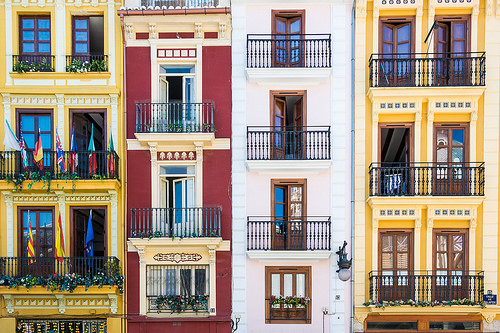
The Mediterranean light makes every street (and photo) dazzle! photo credit: MBarendse valencia (95) via photopin (license)
8 Planning your trip?
You can fly directly into Valencia city from all over Europe, Morocco & Algeria. From elsewhere you can take a connecting flight to Valencia from Madrid, Barcelona & 10 other Spanish cities. You can also travel to Valencia city by high-speed train! The AVE high-speed train connects Valencia city to Madrid city in just 1hr42 mins which is less than half the time it takes to drive! Barcelona is also connected to Valencia by train but it’s not a high-speed version so it takes 3 hrs – which is what it takes to drive. Whether you arrive into Valencia city train station or Valencia airport, you’ll find a decent bus network, taxis and Cabify also works really well here.
